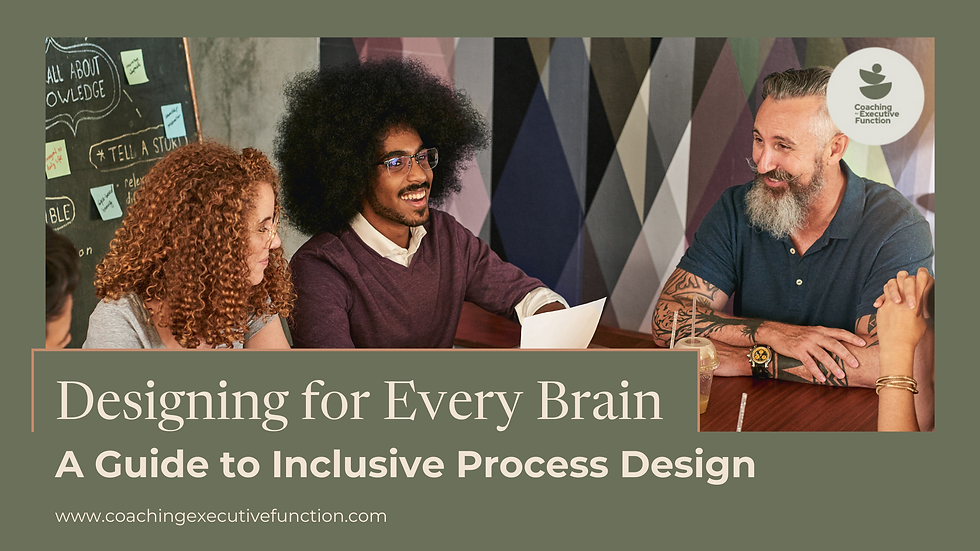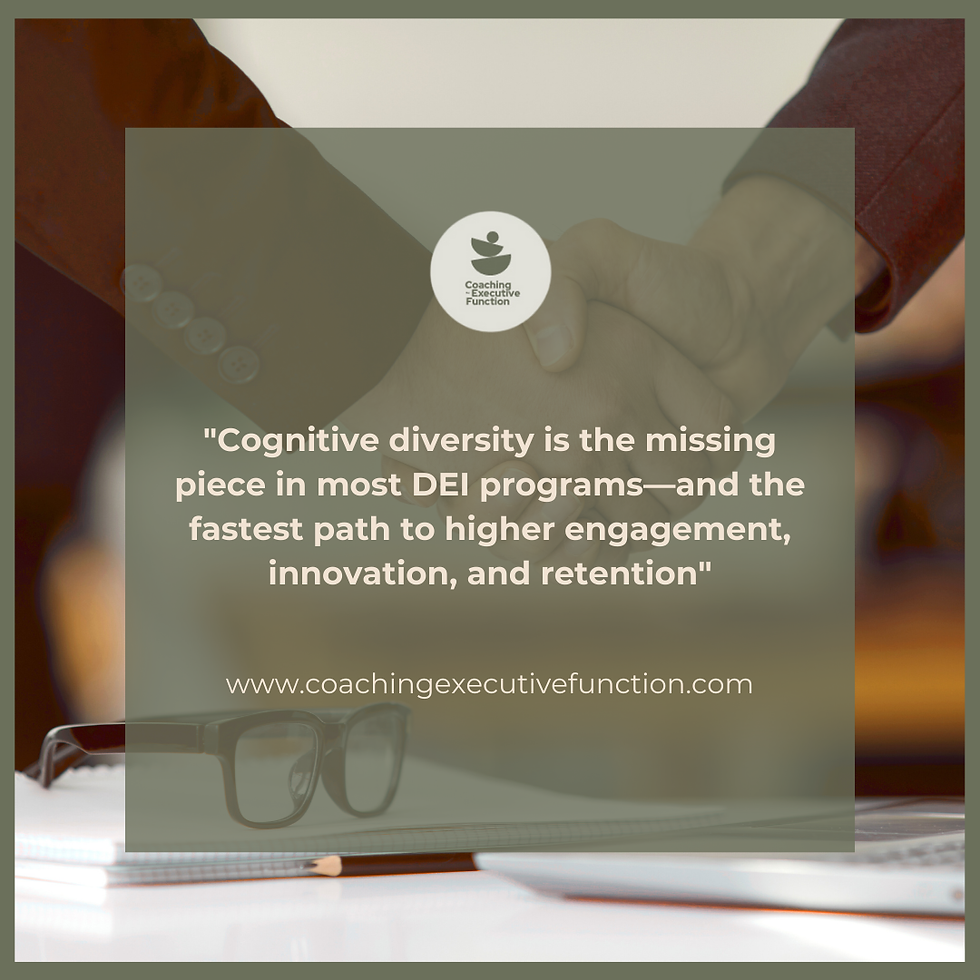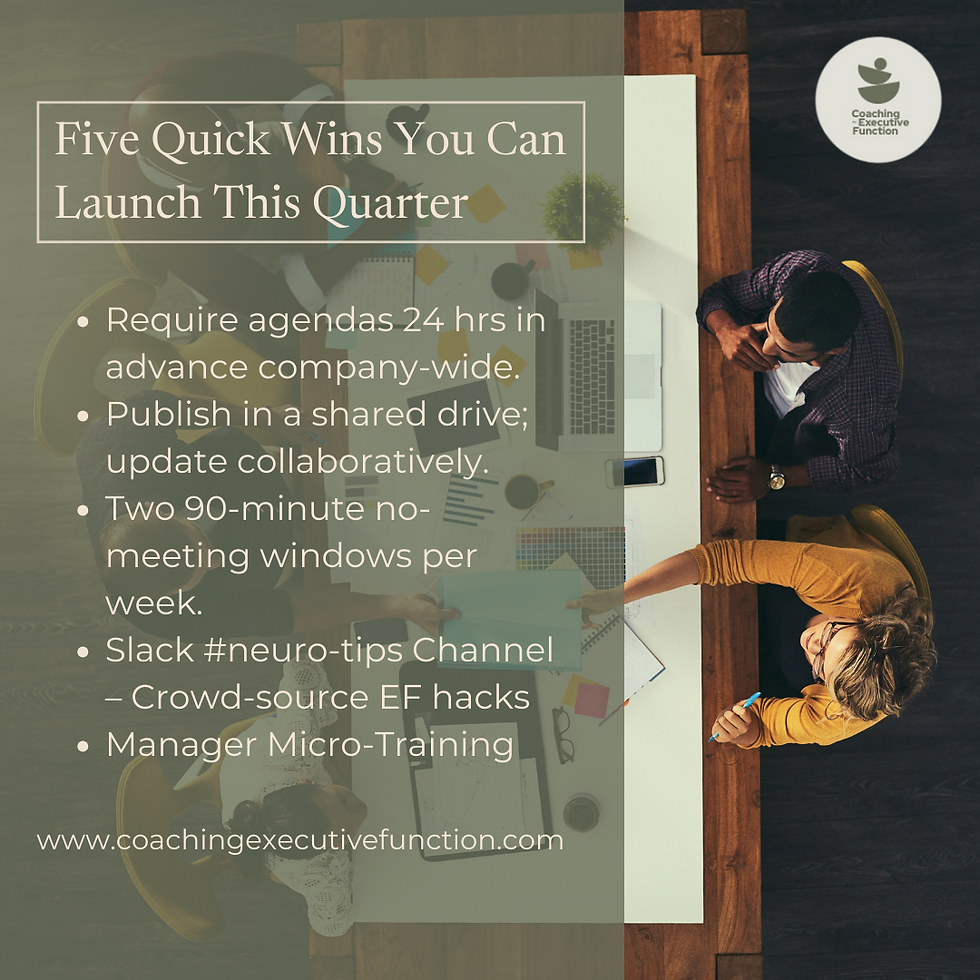Designing for Every Brain: A Guide to Inclusive Process Design
- Jacquelyn Harper

- 23 hours ago
- 4 min read
In today's workplace, traditional DEI initiatives often focus on visible identity markers such as race, gender, and physical disability. However, there is a crucial missing piece: cognitive diversity. By incorporating neurodiversity inclusion into your strategy, you can support the full spectrum of executive-function strengths and challenges, ultimately unlocking the talent you already have. When work processes are designed to respect different working memory capacities, attention profiles, and stress thresholds, you can reduce turnover, boost psychological safety, and gain a competitive advantage.

Why Executive Function is Key to Inclusive Process Design
Executive function (EF) refers to the set of mental skills that includes working memory, flexible thinking, and self-control. When we fail to account for EF in our workflows, we create hidden biases that can sideline talented employees.
The Hidden Biases in Everyday Workflows and Inclusive Process Fixes
Here's how common workplace processes can unintentionally create barriers and how to fix them with inclusive process design:
Workflow Stage | Common EF Barrier | Who Gets Sidelined | Inclusive Process Fix |
Job Posting & Application | Vague requirements or “nice-to-have” bloat | Early-career, ESL, ADHD applicants | Bullet-point must-haves; trim fluff; add “hiring FAQ” doc |
Interviews | Rapid-fire Q&A, ambiguous expectations | Introverts, processing-speed variance | Send agenda & sample questions 48 hrs ahead; allow note-taking |
Onboarding | Info deluge, inconsistent mentors | New hires w/ weak working memory | Step-by-step checklist + onboarding buddy |
Meetings | No agenda, context switching | Anyone with attention regulation issues | 24-hr agenda, timeboxed sections, written recap |
Performance Reviews | Subjective “culture fit” feedback | Employees outside dominant norms | Evidence-based criteria + self-assessment alignment |
The key insight here is that process tweaks beat heroic willpower every time. Rather than expecting employees to adapt to flawed systems, we should be designing systems that work for everyone.
Four Principles for Inclusive Process Design
To build a truly inclusive workplace, focus on these four foundational principles:
Externalize Information: Move tasks, priorities, and project history out of people's heads and into shared, accessible formats like Kanban boards or standard operating procedures (SOPs). This leads to fewer memory-related errors and faster cross-training.
Clarify What, Flex How: Maintain high standards for the quality of deliverables, but provide flexibility in how employees achieve them. This could include allowing the use of headphones, dedicated focus blocks, or alternative note-taking apps.
Chunk, Sequence, Signal: Break large projects into smaller, manageable milestones. Use simple color codes (Green/Yellow/Red) to signal status, which reduces cognitive load and increases transparency.
Normalize Reflective Pauses: Encourage a brief silent count before responding in tense moments. This protects inhibitory control and keeps discussions professional.

Inclusive Process Design in Action
Here’s how you can implement these principles across different areas of your organization to support executive function at work:
Hiring & Interviewing:
Pre-Share Questions: This simple act levels the playing field for candidates with different processing speeds.
Structured Rating Rubric: Use a rubric to eliminate gut-feel bias and boost equity.
Meetings & Collaboration:
Timed Agendas + Live Notes: Agendas with time-boxed sections and real-time note-taking ensure no one gets lost.
Camera-Optional Culture: This reduces sensory fatigue and respects varied bandwidth realities.
Project Management:
Two-Tier Deadlines: Implement a draft date and a final date to safeguard quality without the stress of crunch time.
90-Minute Focus Sprints: Align work periods with ultradian rhythms, which benefits both neurodivergent and neurotypical brains.
Performance & Growth:
EF Skill Workshops: Teach all staff skills like time-chunking, digital-clutter detox, and stress resets.
Process Kudos: Recognize employees who refine workflows, not just those who "power through".
Measuring the Impact of Inclusive Process Design
You can't improve what you don't measure. Here are some key performance indicators (KPIs) to track when implementing these DEI best practices:
Metric | Pre-Implementation | 6-Month Goal |
Employee Engagement (“I feel included”) | 64 % | ≥ 80 % |
Time-to-Fill (diverse candidates) | 47 days | ≤ 35 days |
On-Time Delivery Rate | 82 % | ≥ 92 % |
Voluntary Turnover (cognitive-stress cited) | 10 % | ≤ 5 % |
Track these metrics quarterly, share wins with leadership, and reinvest savings into deeper EF initiatives.
Implement Inclusive Process Design: Five Quick Wins You Can Launch This Quarter
You can start making a difference today with these easy-to-implement changes:
Agenda-First Meetings: Require agendas 24 hours in advance for all company meetings.
Checklists for Recurring Tasks: Publish these in a shared drive and update them collaboratively.
Focus-Block Policy: Institute two 90-minute, no-meeting windows per week.
Slack #neuro-tips Channel: Create a channel to crowd-source ADHD workplace support and other EF hacks, spotlighting a new tip each Friday.
Manager Micro-Training: Hold a 60-minute session on spotting executive-function flags early.

By integrating executive-function supports into your DEI strategy, you can unlock the full ROI of your talent budget and future-proof your culture against burnout and turnover. This is not just a nice-to-have; it's a strategic imperative for sustained success.
Book a consultation or request a customized workshop series to equip your HR and leadership teams with brain-savvy, data-driven strategies that elevate inclusion and performance.








Comments